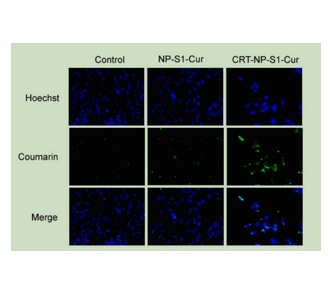文献:PLGA nanoparticles modified with a BBB-penetrating peptide co-delivering Aβ generation inhibitor and curcumin attenuate memory deficits and neuropathology in Alzheimer’s disease mice
文献链接:https://pubmed.ncbi.nlm.nih.gov/29113362/
作者:Na Huang, Shuai Lu, Xiao-Ge Liu, Jie Zhu, Yu-Jiong Wang,Rui-Tian Liu
相关产品:
PLGA20000-PEG3400-NHS 聚乳酸-羟基乙酸共聚物20000-聚乙二醇3400-活性酯
原文摘要:Alzheimer’s disease (AD) is the most common form of dementia, characterized by the formation of extracellular senile plaques and neuronal loss caused by amyloid β (Aβ) aggregates in the brains of AD patients. Conventional strategies failed to treat AD in clinical trials, partly due to the poor solubility, low bioavailability and ineffectiveness of the tested drugs to cross the blood-brain barrier (BBB). Moreover, AD is a complex, multifactorial neurodegenerative disease; one-target strategies may be insufficient to prevent the processes of AD. Here, we designed novel kind of poly(lactide-co-glycolic acid) (PLGA) nanoparticles by loading with Aβ generation inhibitor S1 (PQVGHL peptide) and curcumin to target the detrimental factors in AD development and by conjugating with brain targeting peptide CRT (cyclic CRTIGPSVC peptide), an iron-mimic peptide
that targets transferrin receptor (TfR), to improve BBB penetration. The average particle size of drug-loaded PLGA nanoparticles and CRT-conjugated PLGA nanoparticles were 128.6 nm and 139.8 nm, respectively. The results of Y-maze and new object recognition test demonstrated that our PLGA nanoparticles significantly improved the spatial memory and recognition in transgenic AD mice. Moreover, PLGA nanoparticles remarkably decreased the level of Aβ, reactive oxygen species (ROS), TNF-α and IL-6, and enhanced the activities of super oxide dismutase (SOD) and synapse numbers in the AD mouse brains. Compared with other PLGA nanoparticles, CRT peptide modifiedPLGA nanoparticles co-delivering S1 and curcumin exhibited most beneficial effect on the treatment of AD mice, suggesting that conjugated CRT peptide, and encapsulated S1 and curcumin exerted their corresponding functions for the treatment.
PLGA-PEG共聚物是一种特殊的嵌段共聚物,由聚乳酸-羟基乙酸共聚物(PLGA)和聚乙二醇(PEG)组成。PLGA-PEG共聚物通常具有亲水性的PEG嵌段和疏水性的PLGA嵌段。这种结构使得该共聚物具有两亲性,即同时具有亲水和疏水性质。PEG段的引入可以增加共聚物的水溶性,同时降低其在生物体内的非特异性吸附,从而提高其稳定性。该文献利用PLGA-PEG 制备 PLGA 纳米颗粒,具体如下:

图为:PLGA NP制造的示意图
PLGA-PEG在PLGA纳米颗粒制备中的应用:
采用乳液-溶剂蒸发法制备了PLGA纳米颗粒。简单地说,将姜黄素加入到二氯甲烷中的PLGA-PEG共聚物溶液中,在室温下间歇涡旋保持。将混合物用振幅超声,然后加入胆酸钠,继续振幅超声,得到第二种乳液(w/o/w)。PLGA-姜黄素混合物添加下降胆酸钠水溶液用作表面活性剂在温和磁搅拌,NPs收集离心和洗三次与HEPES缓冲。采用同样的方法分别制备s1载纳米颗粒(NP-S1)、S1和姜黄素载纳米颗粒(NPS1+Cur)、香豆素6标记(NP-C6)和ICG标记纳米颗粒(NP-ICG)。为了封装亲水溶质,采用胆酸钠制备w/o乳液。在同时封装疏水和亲水溶质时,在w/o乳液中同时加入姜黄素和S1。
利用EDC-NHS偶联法将CRT肽偶联到纳米颗粒(CRT-NP-S1+Cur)上,用于脑靶向。首先,将S1和姜黄素负载纳米颗粒(NP-S1+Cur)与NHS和EDC混合。将混合物在室温下轻轻摇动。然后加入CRT肽,再摇晃。最后,收集封装了S1和姜黄素的crt偶联纳米颗粒(CRT-NP-S1+Cur),离心,用HEPES缓冲液洗涤,以去除未反应的EDC。

图为:CRT肽通过bEnd增加了对PLGA NPs的摄取
PEG(聚乙二醇)是一种亲水性聚合物,将其与 PLGA(聚乳酸 - 羟基乙酸共聚物)结合形成 PLGA-PEG 后,PEG 的亲水性链段会在纳米颗粒表面形成一层水化层。这层水化层就像一个 “保护壳”,能够产生空间位阻效应,阻止纳米颗粒之间相互靠近和聚集,从而使纳米颗粒在溶液中保持稳定的分散状态。在生物体内,蛋白质容易吸附在纳米颗粒表面,这可能会引发免疫反应,导致纳米颗粒被免疫系统快速清除。PLGA-PEG 中的 PEG 链段可以减少蛋白质在纳米颗粒表面的吸附,降低纳米颗粒的免疫原性,延长其在体内的循环时间。PLGA 本身的疏水性较强,在水中的溶解性较差,这在一定程度上限制了其应用。而 PEG 的引入可以增加纳米颗粒的亲水性,从而提高 PLGA 纳米颗粒在水相中的溶解性。这使得 PLGA 纳米颗粒更容易在水性介质中分散。

 2025-08-12 作者:lkr 来源:
2025-08-12 作者:lkr 来源:

